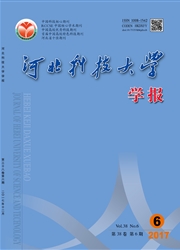

 中文摘要:
中文摘要:
采用双层Lengyel—Epstein模型研究了2个子系统在不同耦合形式下斑图的形成机制。研究3种不同波数比的条件下,耦合形式和耦合强度对斑图的形成的重要作用。当波数比为1时,2个子系统会出现相同的简单斑图(如简单六边形、四边形和条纹斑图),耦合形式和耦合系数的改变未对斑图的形成产生影响;当波数比大于1时,短波系统出现种类丰富的复杂斑图。由于图灵模间发生共振耦合:线性耦合系统出现白眼超六边和类蜂窝斑图,非线性耦合系统选择环状超六边和白眼等复杂超点阵斑图。另外,2种耦合形式图灵模产生共振所需的耦合强度不同。
 英文摘要:
英文摘要:
The formation mechanism of Turing pattern is investigated by the two-layer coupled Lengyel-Epstein model. It is found that the coupling form and strength take an important role in the pattern formation under three wave number ratios between two Turing modes. When the wave number ratio is 1, the same simple pattern can be formed in the two subsystems (such as simple hexagon, quadrilateral and stripe pattern), and coupling coefficient and form have no effect on the pattern formation. When the wave number ratio is more than 1, the short wave mode subsystem can form a variety of superlattice patterns due to the resonance interaction between the two Turing modes: Two complex structures of super hexagon of white-eye and honeycomb-like appear in linear-coupling system, while superlattice patterns of super hexagon of circle and white-eye yield in nonlinear-coupling system. In addition, different coupling strength is required for resonance of Turing-mode in two-kind coupling forms.
 同期刊论文项目
同期刊论文项目
 同项目期刊论文
同项目期刊论文
 期刊信息
期刊信息
